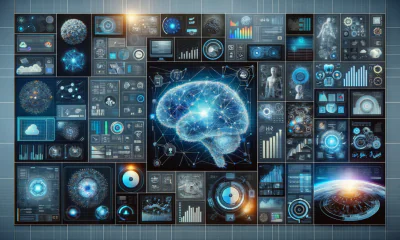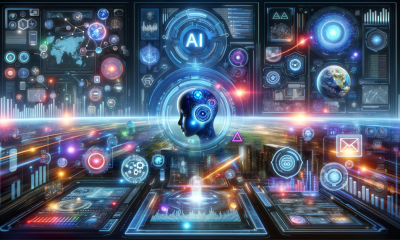Best Of
10 Best AI Assistants (July 2025)
Unite.AI is committed to rigorous editorial standards. We may receive compensation when you click on links to products we review. Please view our affiliate disclosure.

Artificial intelligence (AI) assistants are becoming indispensable in today’s society. You see them everywhere, from smartphones to medical institutions. The number of AI assistants on the market is only increasing, and they will become even more integrated into our lives.
What defines an AI assistant?
What is an AI Assistant?
An AI assistant can be defined as a software program that relies on technologies like natural language processing (NLP) to follow voice and text commands. They are capable of carrying out many of the same tasks as human assistants, such as reading text, taking dictation, making calls, and much more.
AI assistants are often based on the cloud, meaning you can access them anywhere as long as there is an internet connection. To integrate them even more into your day-to-day life, they can be connected to smart devices. The best AI assistants rely on self-teaching algorithms to become highly personalized. For example, they can learn your preferences or speech patterns.
The market for AI assistants has been rapidly growing and becoming more competitive.
Let’s take a look at the 10 best AI assistants:
1. Notta
Notta is an AI-powered transcription and note-taking platform designed to streamline productivity by automatically converting meetings, interviews, and recordings into searchable text. With capabilities for transcription, editing, summarizing, and collaboration, Notta helps users save time and organize information efficiently. It supports transcription in 58 languages, real-time translation for bilingual meetings, and speaker identification for clarity in conversations.
Notta’s one-click summarization feature extracts key points, decisions, and action items from lengthy transcripts, allowing users to share insights across popular platforms like Slack, Notion, and Google Calendar. The platform also integrates with major video conferencing tools, making it easy to record and transcribe meetings on Zoom, Google Meet, and Microsoft Teams.
Ideal for individuals and teams, Notta is trusted by over 5 million users worldwide, including professionals from companies like Salesforce, Coca-Cola, and PwC. With high data security standards (SOC-2, GDPR compliance), Notta offers an all-in-one solution for transcription, translation, and meeting scheduling, making it easier to capture and share critical information effortlessly.
Here are some of the key features of Notta:
- Notta converts meetings, interviews, and recordings into searchable text with AI transcription and translation in 58 languages.
- Offers one-click summaries to capture key points, decisions, and action items for quick sharing.
- Integrates with popular platforms like Zoom, Google Meet, and Microsoft Teams for seamless recording and transcription.
- Provides secure cloud storage and meets SOC-2 and GDPR standards, ensuring data safety.
- Trusted by over 5 million users, including teams from major companies like Salesforce, PwC, and Coca-Cola.
2. Laxis
Laxis is an AI-powered meeting assistant and sales development tool designed to streamline business operations, boost lead generation, and enhance customer interactions. Trusted by over 35,000 professionals from more than 3,000 organizations, Laxis offers powerful features that automate note-taking, generate meeting summaries, and integrate with popular platforms like Zoom and Google Meet.
With its AI SDR feature, Laxis supercharges lead generation by automating outreach and follow-ups, giving businesses access to over 700 million contacts. The platform saves up to 5 hours per week for each user by optimizing sales processes and providing actionable insights from conversations. Laxis empowers teams to close deals faster, improve CRM management, and scale their operations efficiently, making it an ideal solution for businesses of all sizes looking to grow and streamline their workflows.
Here are some of the key features of Laxis:
- Automates lead generation and outreach with AI SDR.
- Records, transcribes, and summarizes meetings automatically.
- Access to 700 million contacts for faster lead qualification.
- Saves up to 5 hours per week through automation.
- Integrates with Zoom, Google Meet, and other platforms.
3. Otter
Get an AI meeting assistant that records audio, writes notes, automatically captures slides, and generates summaries.
Collaborate with teammates in the live transcript, by adding comments, highlighting key points, and assigning action items.
Save time with automated meeting notes by connecting Otter to your Google or Microsoft calendar and it can automatically join and record your meetings on Zoom, Microsoft Teams, and Google Meet. Follow along live on the web or in the iOS or Android app.
When someone shares slides during a virtual meeting, Otter automatically captures and inserts them into the meeting notes, providing complete context of the content that was discussed.
After the meeting, Otter generates and emails a summary that allows you to easily recall and share key information, saving you time from having to revisit the entire transcript.
- Record and transcribe calls instantly.
- Allows adding comments and highlighting key points.
- Connects to Google & Microsoft Calendar.
- Automatically captures and inserts slides into meeting notes.
- Generates summaries automatically and emails them.
4. ChatGPT App
The ChatGPT app, powered by the advanced GPT-4o model, is a cutting-edge tool that leverages artificial intelligence to facilitate seamless and natural conversations with users. GPT-4o, the latest iteration in the series, enhances the app’s capabilities with improved understanding, context-awareness, and response accuracy. This model allows the app to handle complex queries, generate more coherent and contextually relevant responses, and support a wider array of applications, from personal assistance to customer support.
Designed for versatility, the app can be used for tasks such as answering questions, providing recommendations, generating content, and more. Its intuitive interface ensures that users can engage in dialogues that feel natural and human-like. Continuous learning capabilities enable the app to adapt to individual user preferences, making interactions increasingly personalized and efficient over time.
The integration of GPT-4o significantly boosts the app's performance, ensuring that it remains at the forefront of AI-driven conversational tools. This makes it an essential resource for anyone seeking advanced, responsive, and intelligent assistance in various aspects of their daily lives.
- Advanced AI: Utilizes GPT-4o for accurate, natural conversations.
- Versatile Use: Ideal for questions, recommendations, and content creation.
- User-Friendly: Intuitive design for seamless engagement.
- Personalized: Adapts to user preferences through continuous learning.
- High Performance: Enhanced capabilities with GPT-4o integration
5. Fireflies
Fireflies is an AI meeting assistant that uses NLP to eliminate the need for note taking during a meeting. Easily record, transcribe, and search across your voice conversations on an intuitive to use platform.
Instantly record meetings across any web-conferencing platform. It's easy to invite Fireflies to your meetings to record and share conversations.
Fireflies can transcribe live meetings or audio files that you upload. Skim the transcripts while listening to the audio afterwards.
Working in teams becomes a seamless process, add comments or mark specific parts of calls to quickly collaborate with teammates on important moments from your conversations.
The best part might be the search functionality, it enables you to review an hour long call in less than 5 minutes. Search across action items and other important highlights.
- Record and transcribe calls instantly.
- Chrome extension to capture meetings & calls directly from the browser.
- Simple to use search allows easy review of calls.
- An easy to use meeting bot, invite Fireflies bot to a meeting or have it autojoin calls on your calendar.
- Transcribe anything – Transcribe existing audio files instantly inside the dashboard.
- Offers native integrations to dialers, Zapier, or the API to process audio & calls.
- Eliminate note taking.
6. Read AI
Read AI is a productivity tool that enhances efficiency in meetings, emails, and messages through AI-generated summaries, transcripts, playback, and highlights. It requires no software installation or credit card, offering five free meetings per month.
The platform boosts productivity by 20%, allowing users to record and play back meetings, generate instant summaries, and transcribe conversations in multiple languages. It also identifies action items and key questions for streamlined workflows.
Seamlessly integrating with platforms like Zoom, Teams, and Meet, Read AI provides real-time metrics, email, and messaging summaries. It offers actionable feedback based on data from millions of interactions, helping users improve communication with features like a speaker coach and smart scheduling.
Read AI Key Features:
- Read AI provides AI-generated summaries and transcripts for meetings and messages.
- Boosts productivity by 20% with tools like playback and action item tracking.
- Integrates with Zoom, Teams, Meet, and other platforms.
- Offers actionable feedback and smart scheduling.
- Ensures data security with SOC II certification and supports multiple languages.
7. Cortana
Siri’s biggest competitor on the market is Microsoft's Cortana, which is another one of the top AI assistants. Cortana relies on NLP, the Bing search engine, and various forms of data to come up with its personalized recommendations. It’s API’s work with Windows and other 3rd party apps.
Cortana is also compatible with many platforms like Windows 10, Windows mobile, Android, Alexa, and Mixed Reality (MR).
The AI assistant learns from device data to carry out its various functions. Its integration with Alexa helps it control Amazon Smart devices. It is also focused on privacy, meaning you can view and edit the details stored by the assistant.
Here are some of Cortana’s top functions:
- Answers questions
- Provides reminders
- Takes notes
- Helps manage your calendars
- Carries out various tasks
8. Alexa
Amazon’s Alexa is another top AI-powered virtual assistant that has risen in popularity over the years. It is available on many devices, where it uses voice interaction, NLP, voice queries, and much more to carry out tasks. It can also create to-do lists, set up alarms, play audiobooks, and stream podcasts. Some of its other top features include real-time information on traffic, news, weather, sports, and more.
One of the most well-known features of Alexa is its wake-up word, which allows users to activate it with one word. This differentiates Alexa from other devices that require pushing a button. The AI assistant is now being used on more than 100 million devices.
Here are some of Alexa’s top functions:
- Music playback and audiobooks
- To-do lists
- Podcast streaming
- News and sports updates
- Real-time weather and traffic data
9. Google Assistant
Since its launch in 2016, Google Assistant has risen as a top AI-enabled, voice-powered virtual assistant from one of the world’s leading companies. Out of all of the AI assistants on the market, Google Assistant is considered one of the most advanced.
Thanks to various partnerships with several companies, the AI assistant is now available on many devices like smartphones, headphones, home appliances, and cars.
Google Assistant has a wide reach, working with 10,000 devices across 1,000 brands.
Here are some of the top features of Google Assistant:
- Voice and text entry
- Available on many devices
- Voice-activated control
- Task completion
- Reminders and appointments
- Real-time translation
10. Socratic
Another one of the top educational AI assistants, Socratic is an AI-powered app designed to assist students with math and homework. The app enables students to take pictures with their phone camera before using AI to provide visual explanations of the concepts.
Socratic relies on text and speech recognition, and it can be used for different disciplines like science, math, literature, and social studies. It is available on both iOS and Android, and it’s compatible with the iPad.
Here are some of the main features of Socratic:
- Assists students with learning and homework
- Visual explanations of concepts
- Text and speech recognition
- Compatible with various subjects
Summary
Artificial intelligence (AI) assistants have become integral to modern society, appearing in devices from smartphones to medical institutions. Their prevalence is growing, and they are becoming more deeply embedded in daily life.
AI assistants are software programs that use technologies like natural language processing (NLP) to understand and respond to voice and text commands. They can perform tasks similar to human assistants, such as reading text, taking dictation, and making calls. Typically cloud-based, they offer accessibility from anywhere with an internet connection and can be integrated with smart devices for enhanced utility. The most advanced AI assistants employ self-learning algorithms to deliver highly personalized experiences by adapting to users' preferences and speech patterns.
As the market for AI assistants expands, the competition among them is intensifying, leading to continuous improvements and innovations in their capabilities and performance.











